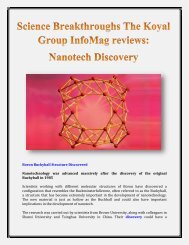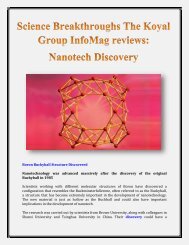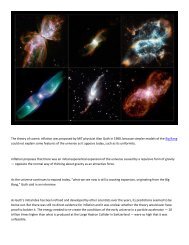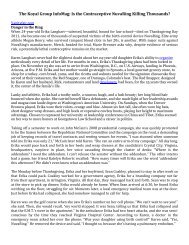o_18u1su2sv1m9c178nql5lqh1seda.pdf
You also want an ePaper? Increase the reach of your titles
YUMPU automatically turns print PDFs into web optimized ePapers that Google loves.
profound impact on the future of nanotechnology, but for now there is no obvious usage for<br />
the molecular structure they discovered.<br />
Endless combinations achieve result<br />
There has been a theoretical model for a boron molecule with similar properties to the<br />
Buckyball, but it had not been observed in experiments until the work by these<br />
researchers. The research involved the computer modelling of over 10,000 structures of<br />
Boron, identifying each by its binding energy. The energies of actual molecules were then<br />
tested using a process called photoelectron spectroscopy, allowing the structures to be<br />
identified.<br />
The experiment returned two 40-atom structures formed by Boron. The first is the<br />
aforementioned ball-shaped cluster. The second is described as a semi-flat molecule by the<br />
researchers. The boron ball is of the most importance because of the theoretical model that<br />
has pointed to it for years, and the fact that it resembles the Buckyball, the progenitor of so<br />
many nanotechnology discoveries.<br />
The 40-atom hollow structure is being called a borospherene by the scientists that<br />
discovered it. A paper concerning its discovery and the experiments that led to it, appears<br />
in the scientific journal Nature Chemistry.<br />
Buckyball: New material may lead to new discoveries<br />
The Buckminsterfullerene was discovered in 1985 and gave rise to much of<br />
nanotechnology’s foundation. The structure spurred the search and discovery of other<br />
forms of carbon with unusual properties. Carbon nano-tubes, a science fiction answer to<br />
many of the world’s problems and graphene, a thin layer of carbon with incredible<br />
strength, that has been touted as one of the material s that will define the twenty-first<br />
century, were both discovered immediately after the Buckminsterfullerene.<br />
Lai-Sheng Wang, a professor of chemistry at Brown University, was one of those who led<br />
the research. He has no idea about the applications of the molecule, but is proud of the<br />
achievement, and excited by it, in and of itself. According to the researcher, “As a chemist,<br />
finding new molecules and structures is always exciting. The fact that boron has the<br />
capacity to form this kind of structure is very interesting.”<br />
“Of course if it turns out to be useful that would be great, but we don’t know yet. Hopefully<br />
this initial finding will stimulate further interest in boron clusters and new ideas to<br />
synthesize them in bulk quantities.” Nanotechnolgy is still a very young science and<br />
discoveries like this one may help to form the basis for many discoveries later on. Just as<br />
the Buckball spurred the discovery of incredible carbon structures, the borospherene may<br />
allow nanotechnology to expand its purview.







